tricky 17-01-2012 21:54
I’m wondering and don’t understand how this happened? All my friends and relatives have a vaccination scar on their left shoulder, but my wife and I don’t. Our years of birth are 82-83. We seem to have been vaccinated. Contact says that 99% of people have a trace. What about the 1%? What do you think.
Drem 18-01-2012 12:06
Either smallpox or tuberculosis.
It seems they still did smallpox in 83, although I’m not sure.
There may not be a scar from tuberculosis. I could be wrong, but it seems like for 82 it should be on the right? Or does this only concern Mantoux... (thinking out loud)
kondor 18-01-2012 01:32
I don't have one either. 83rd.
tricky 18-01-2012 09:43
quote: for 82 it should be on the right?
Neither on the right nor on the left. My younger sister has it, on the left.
Cazador 18-01-2012 10:57
If this bothers you so much, tattoo parlors offer scarring services, order yourself a vaccination scar :-)
Susliks 18-01-2012 11:55
Vaccinations against smallpox in the USSR stopped in 1978-1982.
They vaccinated the smallpox itself and it begins to develop in the body, leaving a scar in the skin, after which the body defeats the smallpox, developing immunity and its effect ceases, and the scar remains for life.
Judging by the year of your birth, the scar could still be from BCG!
After it, a person develops antibodies to tuberculosis and this is manifested in the mantoux reaction, which was performed periodically at school. If the redness is small, then it is considered that this is a consequence of BCG; if it is more (they measured it with a ruler, if you remember), then they are sent for examination with suspected tuberculosis.
A tuberculin test is required before BCG vaccination in all cases, except for vaccination of newborns. A reaction to this test is a contraindication to vaccination. If the vaccine is given to a person with a positive tuberculin test, there is a high risk of severe local inflammation and scarring.
tricky 18-01-2012 18:04
quote: If this bothers you so much - tattoo parlors offer scarring services, order yourself a vaccination scar
I'm rather glad that I don't have a scar. Just curiosity.
Thanks for the answer, but I still don’t understand anything.
quote: Judging by the year of your birth, the scar could still be from BCG!It may not be?
No claim to uniqueness.
Hotei 18-01-2012 19:53
They could vaccinate with saline solution. (this happened)
STFlex 18-01-2012 21:55
I have one on my left, born in 1988.
tricky 18-01-2012 22:14
quote: They could vaccinate with saline solution. (this happened)
"Vaccinate"?
doctorN 18-01-2012 23:16
In St. Petersburg, BCG is done on the right shoulder, in other places - on the left. The scar may disappear with age or be intradermal (only an experienced doctor can assess its presence and size). People born before 1982 have 2 scars - from BCG and smallpox vaccine. In St. Petersburg, these vaccines were given to different hands (BCG - on the right, smallpox - on the left), in other regions - at random
Faule 20-01-2012 12:19
really strange. I have no scars - 83 years old, but my younger brother does - 90 years old
Hotei 20-01-2012 12:35
Although new vaccines were introduced in 1982-1984
Susliks 20-01-2012 12:53
quote: Originally posted by Faule:
really strange.
What’s strange here, different bodies have different reactions to BCG.
Susliks 20-01-2012 12:56
but I still didn’t understand anything.
it all depends on the body’s predisposition to tuberculosis.
there is a predisposition - inflammation and scar,
no predisposition - no scar.
tricky 20-01-2012 16:15
quote: no predisposition - no scar.
Susliks 20-01-2012 16:28
quote: Originally posted by tricky:
It turns out that only 1% of people have a predisposition.
Well, most people walk around with a scar, which is why they still do BCG, but they don’t do smallpox.
Look, the great-grandchildren of our great-grandchildren will not do BCG...
Drem 20-01-2012 16:38
No, at this rate smallpox will be brought back
tricky 20-01-2012 23:57
Confused in the previous post. With a predisposition of 99%
Hotei 23-01-2012 17:11
Small offtopic:
BCG protects against the bone type of tuberculosis, but does not protect against the pulmonary type.
Drem 23-01-2012 17:29
quote: does not protect against pulmonary
Really? Where does such wonderful data come from?
spit 24-01-2012 14:16
And after trying mantu, doctors advised eating suprastin to prevent bloating...
Drem 24-01-2012 17:59
quote: Does BCG generally protect against tuberculosis?
Yes.
quote: They were and still are sick.
And before, both people got sick and died. Do you notice the difference?
Doctor_mengele 24-01-2012 22:30
quote: Originally posted by Hotei:
Small offtopic:
BCG protects against the bone type of tuberculosis, but does not protect against the pulmonary type.
from generalized forms.
Doctor_mengele 24-01-2012 22:32
quote: Originally posted by spit:
Does BCG generally protect against tuberculosis? They were and still are sick. The child's BCG ended with an abscess, which had to be treated with tubazide ointment, and the scar was left with a scar the size of an old nickel.
And after trying mantu, doctors advised eating suprastin to prevent bloating...
Well, it should end with an abscess. And there is often a scar.
And with the mantu sample it’s generally insanity.
They would also recommend putting her on prednisolone.
So that the result will probably disappear.
unname22 25-01-2012 11:36
I’m 87 and don’t have a scar, although most people my age have one.
And the reaction to the mantoux was always great.
doctorN 25-01-2012 13:00
quote: Does BCG generally protect against tuberculosis? They were and still are sick.
ALL vaccines do not protect 100% from the disease. But they reduce the incidence of complications and severe forms of the disease to almost zero.
Hotei 25-01-2012 14:28
Dream,
“It does not protect against infection with the causative agent of tuberculosis, but it really protects against the transition of a latent infection into an obvious disease (in about 70% of those vaccinated), and almost 100% protects children from severe forms of tuberculosis - from tuberculous meningitis, tuberculosis of bones and joints and severe forms of pulmonary tuberculosis."
The scar that almost every Russian has on his left forearm is considered by many to be a mark left by vaccination against smallpox. Such vaccination was mandatory in times Soviet Union, but after 1978 there were noticeably fewer cases of infection, and in 1980 this vaccination was canceled almost everywhere. Why do those born after 1980-1983 also have a similar scar on their forearm, and sometimes even two? The reason was a completely different procedure.
Two different vaccinations
A BCG injection containing weakened tubercle bacilli is given into the muscles of the left arm. Widespread vaccination in the shoulder was introduced just after the abolition of smallpox vaccinations. Scars from two different vaccinations have similarities that often cause them to be confused, and differences that can help determine the true cause of the scar.
Smallpox
The scar left from smallpox always has a characteristic relief; its level is located below the level of the skin, covered as if with waves. Pale in color, 1-6 shades paler than surrounding tissues. What the pigmentation of the atrophied area of the epidermis will be depends on the individual characteristics of melanin synthesis. There are individual differences in diameter, for some it reaches 5 mm in the crossbar, and for others it is more than 10 mm. If a person has gained a lot of weight or pumped up his arm muscles, the atrophic scar will increase in area. Smallpox provokes an inflammatory process with injury to the upper and middle layers of the epidermis, therefore, active production of fibrin occurs at the site of infection. This protein has some interesting features– hair does not grow in fibrous tissue, sweat glands do not pass through, and under the influence of ultraviolet radiation it practically does not synthesize melanin. Therefore, a smallpox scar does not tan and does not have hair.
Interesting! Smallpox leaves only one scar, not two or three. If a person born after 1982-1983 has 2 round scars, one of which is more noticeable and the other less noticeable, the cause of the scarring is definitely not smallpox.
BCG
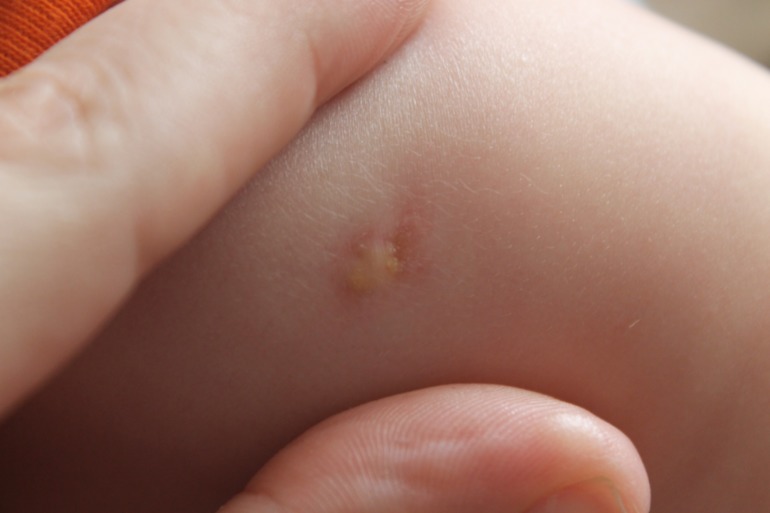
BCG leaves one or two scars, depending on the vaccination method and the individual characteristics of the body. Some people have extremely subtle BCG scars that barely stand out against normal skin. The nature of the scar from such a vaccination is rather normotrophic; it does not sink or rise above the skin level. Its surface has an even texture, without waves or ruts, making it easy to distinguish from all other vaccination scars. The diameter of the scar ranges from 7 mm to 15 mm, much depends on how the graft healed. If during the regeneration process the skin received severe damage (the inflammatory process occurred with the formation of crusts and suppuration), then the scar will be deeper and larger.
If the reaction was calm, after 10-20 years it will be difficult to distinguish it on the shoulder.
How to remove an old scar?
If you look at your left shoulder now, you will definitely see a round or oval-shaped mark there. Everyone in your circle has it - colleagues, classmates, relatives. What is this? This is a trace from vaccination, which is carried out in the first days of a child’s life. What is the left shoulder vaccinated against in childhood? “Popular about health” will answer this question and explain why this vaccination leaves a scar for life.
Why is a vaccine given to the left shoulder in childhood??
A scar or mark on the left shoulder remains after the BCG vaccination against tuberculosis. This vaccine must be administered to a newborn on days 3-7 of his life. The component of such a vaccine is a strain of bovine tuberculosis bacilli; it is grown artificially in laboratories. These microorganisms are alive, but they are not capable of causing tuberculosis in humans, since they are greatly weakened and inactivated. Once in the body, the vaccine promotes the development of stable immunity to tuberculosis, which lasts for five to seven years.
Why does this vaccine leave a scar??
Children receive many vaccinations, but only one leaves a scar for life. Why? The fact is that the body’s natural reaction to the BCG vaccine is the occurrence of an inflammatory or even necrotic process after the injection. After vaccination carried out in the maternity hospital, the doctor warns the baby’s mother about this and gives the following recommendations:
The source of inflammation is not treated with anything.
The injection site must not be scratched or the scab removed.
Do not apply bandages to the formed lump.
According to the doctor, it is completely normal for some children to develop a lump at the site of the BCG vaccine that rises above the skin. Then the bubble bursts, festers, and closes again. This process can last up to two months, and sometimes longer. Does the presence of a scar indicate that the vaccination was done incorrectly?
A scar is a sign of nurse incompetence?
If you have a large, unsightly scar from a childhood vaccine, this does not mean that you were vaccinated by an inexperienced or incompetent nurse.
Think about it, if this were so, then the trace of the vaccine would not remain on all people, but only on some. But everyone, or almost everyone, has it. Moreover, the mark remains even in those people whose wound did not become inflamed after the injection in childhood and healed quickly. The presence of a scar is not associated with incorrect actions of the nurses who performed the vaccination.
Why do some people have two or even three marks??
People born before 1978 may have multiple vaccine marks on one arm. One of them, as we found out, is left behind by the tuberculosis vaccine, the so-called BCG. The other is from smallpox. In the Soviet Union, this vaccine was given to everyone, since there were often outbreaks of this terrible disease. In 1979, smallpox vaccination was canceled because the disease had been eradicated.
Interestingly, the scar from the smallpox vaccine is more noticeable than from tuberculosis. The vaccine site can be up to one and a half centimeters in size, be recessed in relation to the surface of the skin and have uneven edges and structure.
Some people have as many as three similar scars. What does this mean? At the age of seven, revaccination with BCG is carried out. Usually there is no trace left after it, since the body’s reaction at this age is no longer so pronounced, however, some people still experience an inflammatory process at the injection site. As a result, another scar remains.
There is no scar on the left shoulder - what does this mean??
If a person has no scars, there are several reasons:
1. Human skin regenerates quickly.
2. Vaccinations were not given due to existing contraindications (the newborn had contact with a patient with tuberculosis, he was diagnosed with immunodeficiency or other diseases).
3. Parents did not give permission for vaccination.
Is it possible to get rid of marks??
So, we found out why an injection is given in the left shoulder in childhood. Now - only from tuberculosis, and earlier, until 1978, also from smallpox (different from chickenpox). Many people do not like the presence of scars on the shoulder; they spoil the appearance of the skin and are difficult to deal with ultraviolet radiation. Today you can get rid of these defects using cosmetic procedures. For example, you can resort to laser skin resurfacing or dermabrasion. These methods are absolutely safe and painless and allow you to achieve absolute smoothness of the skin where there are any unevenness left after injections or other impacts.
So, now you know exactly what diseases you were vaccinated against in your shoulder in childhood. Currently, vaccination in this part of the body is carried out only against tuberculosis. The first time this happens in the maternity hospital, the second time at seven years old, the third time at 14 years old. In some countries, for example, in Ukraine, the third BCG vaccination has been canceled since 2002. The presence of scars does not indicate the incompetence of the medical staff, as we found out. If you wish, you can easily get rid of unsightly scars using modern methods corrections.
Today we can talk about the existence of two main types of smallpox - chickenpox and natural. Chicken pox is relatively harmless compared to natural ones. Epidemics smallpox raged in Russia and Europe from about the 10th century, although ancient Roman historians also made separate references to this terrible disease. Natural foci of smallpox are located in the region of Eastern Siberia, China and India, and it was there that this infection first appeared. In 10th-century India and China, smallpox killed between a third and half of the population. Smallpox was first brought to Europe by soldiers of the army of Alexander the Great, and then spread throughout the continent by the Ottoman Turks during their campaigns of conquest.
The mortality rate from smallpox ranged from 50 to 70%, and was so common that the special signs of police reports in France in the 17th century indicated “no traces of smallpox.” Given the enormous scale of epidemics and the development of effective and safe vaccines, the World Health Organization in the 60s declared its intention to eliminate the terrible infection. Smallpox was eventually eradicated in 1980, and the last confirmed case was reported in 1978 in Bangladesh. Due to the successful eradication of smallpox from the world, vaccinations against it were discontinued in the 1980s.
However, today virologists and epidemiologists are extremely worried because the blackpox virus has spread to great apes. This means it could reenter the human population when herd immunity completely disappears. Today, the number of people who are not vaccinated against smallpox is huge - several generations who were born after the 80th year. But previous generations who were vaccinated against smallpox are still alive, and it is thanks to these people that collective immunity is maintained. In connection with the current epidemiological situation, scientists are thinking about the advisability of introducing the smallpox vaccine again.
Smallpox vaccination
Today in Russia graft smallpox treatment is routinely given to people who may become infected with this infection due to the nature of their work. In addition, there is a stock vaccines for vaccinating people in the event of smallpox detection in the country. Today in Russia there are three types of smallpox vaccines, which are used for different purposes:1. Dry smallpox vaccine live (applied cutaneously).
2. Dry inactivated smallpox vaccine (used for two-stage vaccination against smallpox).
3. Live embryonal smallpox vaccine, in tablets intended for oral use (TEOVac).
Anti-smallpox vaccine in tablets is used exclusively for revaccination, that is, for activation in previously vaccinated people. Inactivated dry vaccine contains killed smallpox and is used for primary vaccination, requiring two doses to create immunity against infection. Dry smallpox vaccine with live attenuated viruses is used for emergency vaccination, and one dose is enough to form immunity. To carry out vaccination against smallpox, special sterile instruments are required.
Dry live smallpox vaccine contains weakened viruses, which are obtained by growing them on the skin of cattle calves. The dry preparation contains 5% peptone and phenol as a stabilizer and preservative. Separately, the solvent for the vaccine – 50% glycerol – is sealed into sterile ampoules. This type of vaccine is produced in ampoules of 10 and 20 doses. The dry vaccine at a temperature of 2 - 8 o C retains its properties for 2 years, and the solvent - for 3 years.
Dry inactivated smallpox vaccine contains killed viruses that are grown on the skin of calves. Then smallpox defects are removed from the skin of calves, and the viruses are killed by irradiation with radioactive cobalt - 60. A sterile saline solution is used as a solvent for the dry vaccine.
It was this vaccine that was used in the USSR for mass vaccination of the population until 1980. The vaccination was carried out in two stages. But this type of vaccine can only be used for primary vaccination, and cannot be revaccinated. The vaccine is produced in sterile ampoules of 10 doses, its properties are preserved for 2 years at a temperature of 2 - 8 o C.
Live smallpox vaccine tablets It is used orally, exclusively for revaccination. The vaccine should not be used in previously unvaccinated people. The tablets contain live and weakened smallpox viruses that are grown in chicken embryos. Lactose is used as a stabilizer, and sucrose, vanillin and stearate are used as fillers. The outside of the tablets is coated with cellulose acetate, castor oil and oleic acid. One tablet is one dose of revaccination vaccine.
The tablet is gray-white or brown in color, has a distinct and pleasant smell of vanillin, and tastes sweet. Smallpox vaccine tablets are produced in blisters or glass vials.
Is there a smallpox vaccine?
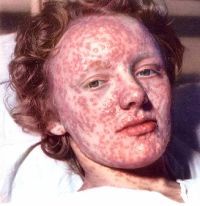 Today, mass vaccination against smallpox is not carried out in Russia, since the infection was eradicated back in 1980. However, there are a number of categories of people who have a potential risk of contracting smallpox due to the nature of their work. These people are at risk and are required to be vaccinated against smallpox. According to the decrees of the Russian Ministry of Health, compulsory smallpox vaccination is currently being given to the following categories of people:
Today, mass vaccination against smallpox is not carried out in Russia, since the infection was eradicated back in 1980. However, there are a number of categories of people who have a potential risk of contracting smallpox due to the nature of their work. These people are at risk and are required to be vaccinated against smallpox. According to the decrees of the Russian Ministry of Health, compulsory smallpox vaccination is currently being given to the following categories of people: 1. Employees of territorial bodies for epidemiological surveillance.
2. Doctors, nurses and orderlies of infectious diseases departments and hospitals.
3. Doctors, laboratory assistants and nurses in virology laboratories.
4. Doctors, nurses and orderlies of disinfection units.
5. All hospital, ambulance, and outreach personnel who work in a smallpox outbreak.
Today, two-stage vaccination against smallpox is routinely used. At the first stage, an inactivated smallpox vaccine is administered subcutaneously, and at the second stage, a week later, a live vaccine is inoculated on the skin surface of the shoulder. All of the above workers are vaccinated against smallpox, revaccination is carried out after 5 years. Experimenters and scientists working directly with the culture of blackpox viruses must undergo revaccination once every 3 years.
If cases of black smallpox are discovered in Russia, all people living in the region and all workers who are sent to this area to perform their duties, including medical personnel, are vaccinated against smallpox. If people were vaccinated early, they must undergo revaccination before entering the outbreak. In addition, all contacts of a person with smallpox are separately identified and all these people are vaccinated.
If a person travels to potentially dangerous regions, or his occupation is associated with a potential risk of infection with the smallpox virus (for example, people working with great apes), he can go to the clinic at his place of residence and apply for vaccination. In this case, the vaccine is specially ordered, and the person is vaccinated, and information about this is entered into the medical documentation.
Vaccination against smallpox - manipulation technique
Let's consider the technique of vaccination against smallpox, which is carried out using a two-stage method. Before vaccination, it is necessary to carefully examine the person:- identify chronic and past diseases;
- reveal ;
- conduct urine and blood tests;
- if necessary, take an electrocardiogram or electroencephalogram, do fluorography.
The first stage of smallpox vaccination
 The prepared diluted vaccine in an amount of 0.5 ml is administered subcutaneously into the shoulder, at a distance of 10 cm from the shoulder joint. If there are already scars from vaccinations on the skin of the shoulder, then choose the area where they are absent. Then wait 1 week (7 days) and carry out the second stage. If after a week the second stage of smallpox vaccination has not been completed, then it can be carried out within 2 months, starting from the moment of the first stage.
The prepared diluted vaccine in an amount of 0.5 ml is administered subcutaneously into the shoulder, at a distance of 10 cm from the shoulder joint. If there are already scars from vaccinations on the skin of the shoulder, then choose the area where they are absent. Then wait 1 week (7 days) and carry out the second stage. If after a week the second stage of smallpox vaccination has not been completed, then it can be carried out within 2 months, starting from the moment of the first stage. Second phase
The second stage of vaccination involves the skin application of live smallpox vaccine to the outside of the upper arm. To apply the vaccine, choose a place without scars from previous vaccinations. Skin application can be carried out using scarification or multiple injections.For the scarification method, a smallpox vaccination pen is used, and for multiple injections, a bifurcation needle with two teeth is used. Before applying the vaccine, the skin area is wiped with alcohol and left to dry. Then, when using the scarification method, a drop of the vaccine is applied to the skin with a glass rod. Then the skin in the area where the vaccine is applied is stretched, and the skin is cut 5 mm with a smallpox vaccination pen so that a scratch is formed that does not bleed. Rub the vaccine into the incision with a feather and leave the skin open for 10 minutes. If revaccination is carried out, then two drops of the vaccine are applied and, accordingly, two incisions are made with a smallpox vaccination pen. After grafting, the edges of the incision should swell and turn red.
For the multiple injection method, a bifurcation needle is taken and dipped into the vaccine. Then, with this needle, five injections are made on the skin, within 0.5 cm. If a person is revaccinated, then 15 injections are given. After the injections, drops of lymph and blood appear on the skin, and its surface remains open for 10 minutes.
Over the next 3 weeks (21 days), you should be careful about the vaccination site - it should not be rubbed, irritated, combed or wetted excessively. After the crusts appear and until they fall off, it is necessary to apply a dry gauze bandage to the injection site, and also wear long sleeves made from natural fabrics. Change the bandage every day, but do not touch the wound with your hands and do not try to tear off the scabs. Be sure to wash your hands after changing the dressing.
Revaccination with tablets
Live tablet smallpox vaccine is used for booster vaccination only. The tablet can be taken only in the absence of serious diseases and wounds in the oral cavity. The vaccine, in tablet form, is slowly absorbed in a person's mouth. After taking the tablet vaccine, you must refrain from smoking, eating, drinking and frequent swallowing of saliva for half an hour.All vaccinations and revaccinations against smallpox are recorded in the medical records. If a one-stage smallpox vaccination method is used, then the drug is immediately applied to the skin using scarification or multiple injections. With this one-stage method of smallpox vaccination, complications are more often observed, and reactions are more pronounced than with the two-stage version.
First smallpox vaccination
The first vaccination against smallpox is given inactivated vaccine, therefore practically does not cause reactions from the human body. However, a quarter to a third of those vaccinated may see slight redness at the injection site a day after the procedure. Redness may be accompanied by the formation of a small lump. In addition to the local reaction in the form of redness and thickening, a slight increase in temperature (up to 37.5 o C) is possible. These reactions go away on their own within 1 to 2 days.If vaccination is carried out using a one-stage method (scarification or multiple injections), then stronger reactions may develop after the drug enters the bloodstream. In this case, grafting elements are formed at the site of vaccine application. 3–4 days after application of the vaccine, swelling, redness and a small papule form in this area, gradually increasing in size. By day 6, a red rim forms around the papule, and it turns into a vesicle - a small bubble filled with liquid. After 2–4 days, the vesicle turns into a pustule, in place of which a scab forms. After complete healing of the wound, the scab disappears, and a scar remains in its place. The entire vaccination reaction from the moment the papule forms until the crust falls off usually occurs within 21 days.
During the formation of the scab, other symptoms may appear, for example, an increase in temperature up to 39.0 o C, headache, inflammation of the lymph vessels, malaise, weakness. The effectiveness of the vaccination is assessed on the 8th day after vaccination. The vaccination is considered good if a pustule has formed. If the vaccination is ineffective, then a secondary vaccination is performed on the other shoulder.
These post-vaccination reactions develop only in those who are vaccinated against smallpox for the first time. If a person undergoes revaccination using the method of scarification or multiple injections, then all reactions occur much faster. The formation of a papule and its convergence takes place within 4–5 days, and in some people – in 1–2 days. In rare cases, a papule may turn into a vesicle. The state of vaccination is assessed 2–4 days after revaccination. Revaccination is considered successful if a papule, pustule, vesicle, redness or thickening has formed on the skin.
Second smallpox vaccination
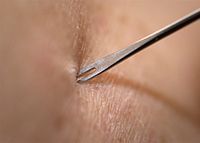 The second smallpox vaccination is done by applying the vaccine to the skin (with a pen or a bifurcation needle). Usually, a mild local reaction is formed at the site of application of the vaccine - redness, swelling, swelling, the formation of papules, vesicles and pustules. The papule degenerates into a vesicle (a bubble with liquid), which becomes a pustule, covered with a crust. The crust dries out and falls off, leaving a scar in its place. In addition to these local reactions, fever, inflammation of the lymph vessels and malaise are possible. Usually these reactions go away quickly - within a week.
The second smallpox vaccination is done by applying the vaccine to the skin (with a pen or a bifurcation needle). Usually, a mild local reaction is formed at the site of application of the vaccine - redness, swelling, swelling, the formation of papules, vesicles and pustules. The papule degenerates into a vesicle (a bubble with liquid), which becomes a pustule, covered with a crust. The crust dries out and falls off, leaving a scar in its place. In addition to these local reactions, fever, inflammation of the lymph vessels and malaise are possible. Usually these reactions go away quickly - within a week. In rare cases, it is possible to develop a strong reaction to the second smallpox vaccination, which is expressed in an increase in body temperature to 39.0 o C, the formation of a large area of redness and swelling, as well as the formation of several papules. A rash may appear.
The effectiveness of the vaccine is assessed on the 8th day after vaccination. If a pustule developed at the site where the drug was applied, the vaccination led to a good result.
The injection site turned red
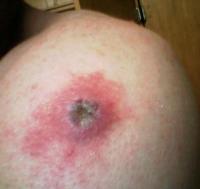 The appearance of redness at the site where the smallpox vaccine was administered is a normal reaction of the body. Redness is caused by a local inflammatory reaction, which is always accompanied by varying degrees of redness, swelling, swelling and pain. Sufficiently severe symptoms can lead to temporary limitation of arm mobility. However, these symptoms, including redness, will go away on their own after a short period of time. To alleviate the subjective condition, you can take medications from the group of non-steroidal anti-inflammatory drugs (for example, Nurofen, Nimesulide, Nise, Ibuprofen, etc.).
The appearance of redness at the site where the smallpox vaccine was administered is a normal reaction of the body. Redness is caused by a local inflammatory reaction, which is always accompanied by varying degrees of redness, swelling, swelling and pain. Sufficiently severe symptoms can lead to temporary limitation of arm mobility. However, these symptoms, including redness, will go away on their own after a short period of time. To alleviate the subjective condition, you can take medications from the group of non-steroidal anti-inflammatory drugs (for example, Nurofen, Nimesulide, Nise, Ibuprofen, etc.). Scar after vaccination
Today, many people are interested in whether they were vaccinated against smallpox, since there are some scars on their shoulders, but almost no one remembers which vaccinations they received. In the USSR, vaccination against smallpox was abolished in 1978–1982. This means that all children born after 1982 no longer received the smallpox vaccine. Many try to object: “What about the scar on the shoulder? After all, it’s smallpox!” Unfortunately, there is confusion when people mistake the scar from the BCG (against) vaccine for a characteristic “pockmark.”The smallpox vaccination scar is quite large - from 5 to 10 mm in diameter, and the skin is somewhat recessed. The entire surface of the scar is covered with characteristic irregularities in the form of bulges and dots that resemble potholes. This scar is clearly visible on the shoulder of people who were born before 1983. Additionally, people vaccinated against smallpox have scars on both shoulders.
Generations born after 1982 were not vaccinated against smallpox, but were vaccinated against tuberculosis. The TB vaccine also heals to form a scar. They are usually very small, barely noticeable on the skin of the shoulder. There may be one or two scars. If the BCG vaccination healed with the formation of a large crust (maximum 1 cm in diameter), then the scar may be large and very similar in size to smallpox. However, the surface of the BCG scar is flat, smooth, and not pitted, unlike “pockmarks”.
When is smallpox immunization given?
Currently, children are not routinely vaccinated against smallpox. If for some reason a person needs to be vaccinated against smallpox, then this can be done at any age, in the absence of contraindications. It is recommended to vaccinate a child no earlier than 1 year, if necessary. Let's consider when a smallpox vaccination is given in the presence of various pathologies:| How long after recovery is being done smallpox vaccination | Disease |
| Immediately after recovery | due to deficiency of iron, folic acid, B 12, etc. |
| 2 months later | Any acute pathology |
| Herpetic skin rashes | |
| Chicken pox | |
| Pustular skin lesions | |
| Chronic tonsillitis | |
| Adenoids | |
| Any operations | |
| In 3 months | Chronic |
| In six months | Infectious (except C) |
| Meningococcal infection | |
| Chronic infections, including sepsis | |
| Pathology of the bile ducts | |
| Toxic damage (salt poisoning heavy metals etc.) | |
| Allergic reactions | |
| In a year | Chronic pneumonia |
| In three years |
In the presence of certain diseases, smallpox vaccination can be given only after examination by a specialist who will assess the person’s condition and ability to adequately tolerate vaccination. Conditions that require mandatory specialist approval for smallpox vaccination include the following:
- Little's disease;
- traumatic injuries of the central nervous system;
The BCG vaccination, also known as Bacillus Quelmetta-Garena, is one of the first vaccinations given to newborns in order to develop immunity to tuberculosis.
After healing, a small scar the size of from two to ten millimeters. This may confuse parents who have not experienced this type of vaccination.
Vaccination healing rate, why a scar remains
Usually, if there are no contraindications, this vaccine is administered in the first days of life child. The drug, consisting of specially bred mycobacteria that cannot infect humans, is administered intradermally.
After injection, the skin forms papule(seal) several millimeters in size, which gradually resolves.
Administration of the drug deep into the skin very important: if it enters the subcutaneous space (which can happen due to injury to the injection site or incorrect administration of the vaccine), the virus can penetrate the lymph nodes and bloodstream, causing extensive infection of the body.
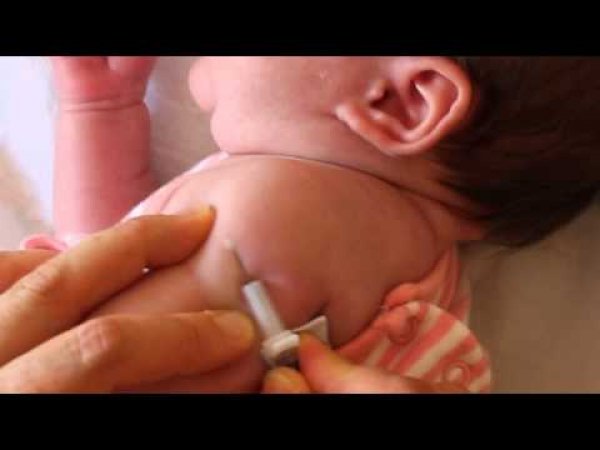
Photo 1. The process of vaccinating a baby with BCG, the vaccine is injected carefully under the skin on the left shoulder.
The healing process itself takes quite a long time, up to four and a half months, and is not always simple. So, usually redness first appears at the injection site, which over time acquires a darker color, even dark purple. After some time it forms small abscess, which will slightly ooze pus; no need to worry: it's normal process, showing that the body responds correctly to the vaccine.
If pus comes out of the wound freely, it is quite acceptable to cover it gauze, periodically changing the bandage. It is because of the abscess that a scar forms at the site of vaccination: the abscess becomes covered with a scab, and then, after completion inflammatory process, a small red pimple forms at the injection site. After some time, its walls will begin to thicken, and it itself will settle. This will continue until the tumor is completely transformed into scar tissue - scar, which will last for several more years until re-vaccination.
In some cases, the appearance of the injection site may differ from that described above. This is often due to some side effects which can harm the child’s health. In these cases, you should immediately consult a doctor: the sooner treatment is started, the higher the chances of a favorable outcome without consequences for appearance and the body itself.
Attention! Under no circumstances should you treat the abscess with antibiotics and ointments, or try to squeeze out the pus. This will lead to the vaccination process will be violated and it will either turn out to be ineffective, or pus along with Mycobacterium tuberculosis will enter the subcutaneous space, which can provoke BCGitis (or, in rare cases, necrosis of surrounding tissues and the development of bone tuberculosis).
Keloid scar, photo
A keloid scar is one of the complications. It occurs extremely rarely, as a result of a specific reaction of the body to the vaccine. Typically this type of complication occurs in a year after vaccination, when the abscess has already healed. It is the same type of scar as the one formed as a result of burns. This is a swollen, irregularly shaped scar, usually red in color, due to the constantly developing network of capillaries inside.
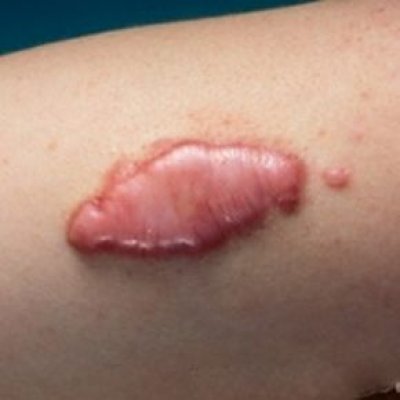
A keloid scar develops quite quickly at first, then slows down its growth, never truly stopping.
Usually a keloid continues to grow, gradually capturing more and more surface of the skin. In this case, growth may be accompanied by itching, pain and redness (in rare cases).
There are currently ways to slow the growth of these scars. They include chemotherapy or radiotherapy.
Unfortunately, even conservative methods of treatment, which involve surgical intervention, do not always give good results: the keloid continues to grow on the edges of the wound formed after removal of the scar and represents a pathological change in the soft tissues adjacent to the injection site.
Important! If you have a keloid scar, you should never re-vaccinate due to the characteristics of the body, which reacts to BCG in this way.
Healing without a scar
In some cases, a scar may not form after vaccination. This is usually due to one of the following reasons:
- Innate immunity. In rare cases, the child already has innate immunity, which is strong enough to overcome the introduced mycobacteria. On the one hand, this is a big plus, since immunity already exists, on the other hand, it will be present in the body not so long, like an artificially grafted version. There is a chance that the child will become infected with tuberculosis before the re-vaccination is given.
- Incorrectly administered vaccination. The vaccination may be placed incorrectly, causing a scar to form. in the skin itself and invisible from the outside. A TB doctor can easily determine the presence of even this type of scar. Also, a trace of the injection may not remain if it develops side effects(but other consequences of the injections will be visible).
Interesting. In cases where the skin on the shoulder is too thin and does not allow the vaccine to be injected into the skin itself, the doctor may decide to give an injection in thigh skin, where the density of the skin is much higher, and therefore the chance of incorrect vaccination is lower. However, an experienced doctor always administers the vaccine correctly, since the arm is already full.
It is important to note that the absence of a scar in no way means that the child has tuberculosis. If there were Mycobacterium tuberculosis in the body, serious inflammation would quickly form at the injection site, developing into necrosis. This is due to the fact that if the body has Mycobacterium tuberculosis, which it fights, the immune response will be incredibly strong, which will cause similar changes in the soft tissues.
However, this development of events almost impossible. This is due to the fact that before vaccination, doctors conduct a tuberculin test, which shows whether the child is infected with tuberculosis. In cases where there is a suspicion of problems with immunity or congenital diseases, vaccination is postponed either until immunity is restored or until the child is cured of an existing disease.
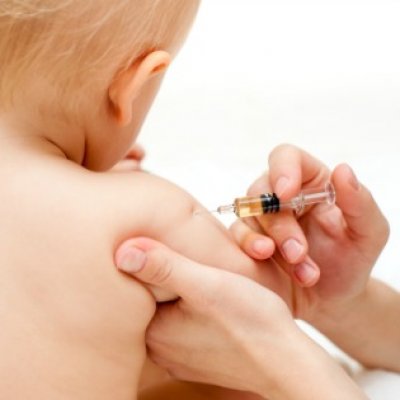
BCG vaccine cannot infect person with tuberculosis. It is not virulent for the human body, as it is weakened Mycobacterium tuberculosis, which are typical for cattle.
The same mycobacteria consist of various subtypes of BCG vaccine, used to vaccinate children at different stages of life, depending on the characteristics of their body and immunity, and in some cases suitable for premature babies.
The difference between these vaccine subtypes is only in the concentration of live microorganisms.
It is also worth noting that vaccines do not cause autism in children, no matter how modern activists insist on it. There are no studies to support such a claim. This is especially true for the BCG vaccine, which has been known to mankind for almost 100 years.
Important! With the initially small size of the scar, we can say that the immune system is quite weak and will only last for three years. In such cases, a TB doctor may prescribe additional vaccination. In most cases, experts recommend waiting until re-vaccination, which is done at age seven years old.
The significance of the scar after BCG
The scar after this vaccine is extremely important: in the first period of life, before the second vaccination, this scar appears indicator that the immune system is still active. The closer the second vaccination is, the smaller the scar becomes.
Tripe - normal reaction body to the vaccine; It is safe to say that there is no need to deal with the scar left by BCG in any way. Among other things, it serves as an unambiguous indicator that a person has been vaccinated against tuberculosis, even if he himself does not remember it.
